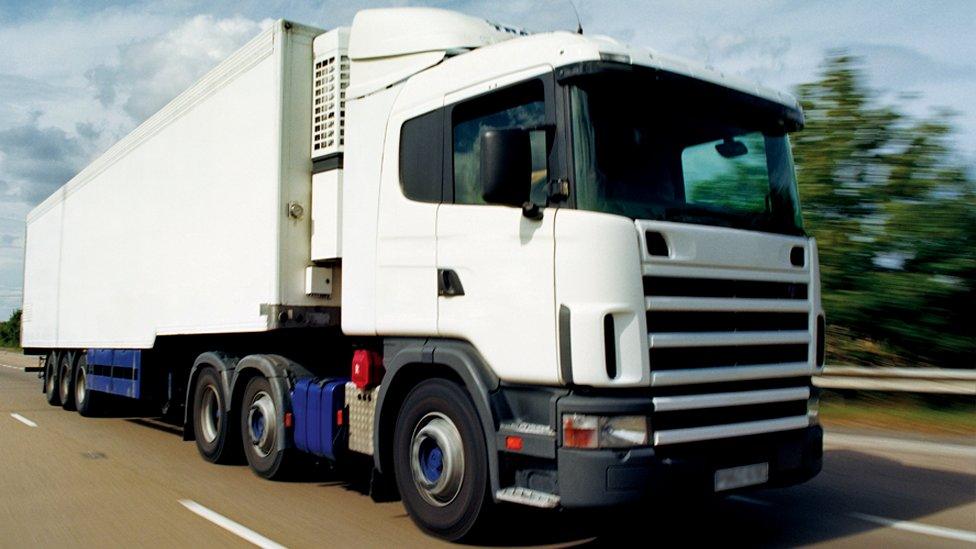Lorry driver shortages: 'Driving lorries is a bit like riding horses'
- Published
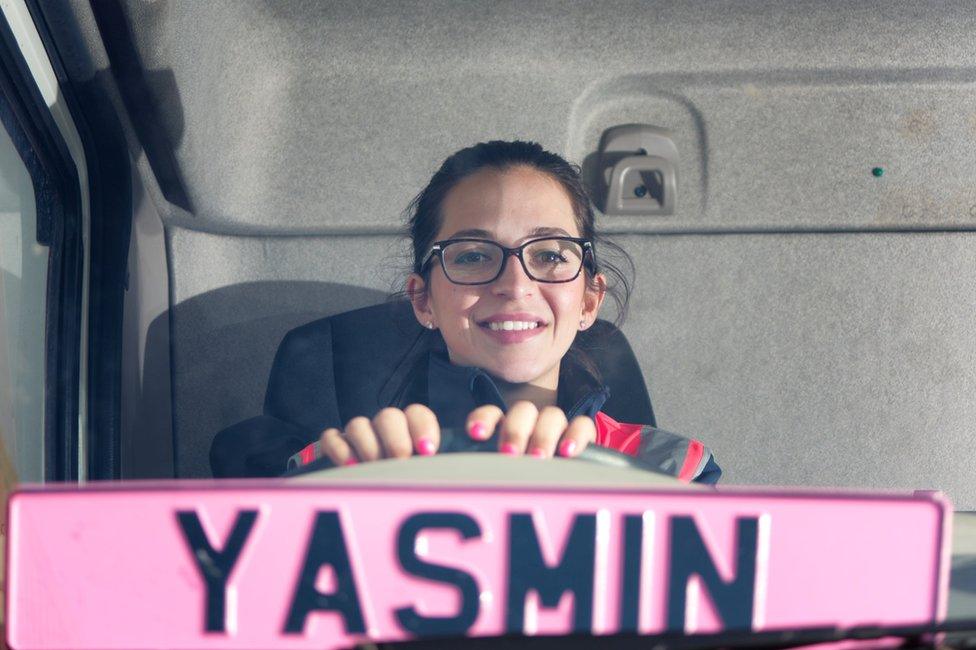
Being the "new young female" with a large hauliage firm was "daunting", says Yasmin Jobsz
The Road Haulage Association (RHA) estimates there is a shortage of more than 100,000 qualified drivers in the UK. But what is the industry like for those just starting out as lorry drivers?
"The first day was really daunting," says 25-year-old lorry driver Yasmin Jobsz.
"To be the new young female walking on to the yard for the first time was daunting because I did not know what they would be thinking.
"They could have been thinking 'oh she's not going to last long or whatever'."
As it was, however, they were "all really, really nice and they've all helped me out".
She is driver with Bartrums, based in Eye, Suffolk. It has 160 vehicles in a fleet that will cover 11 million road miles by the end of the year.
Yes, occasionally she gets funny looks from some people either on the road or when she arrives in her 18-tonne DAF lorry.
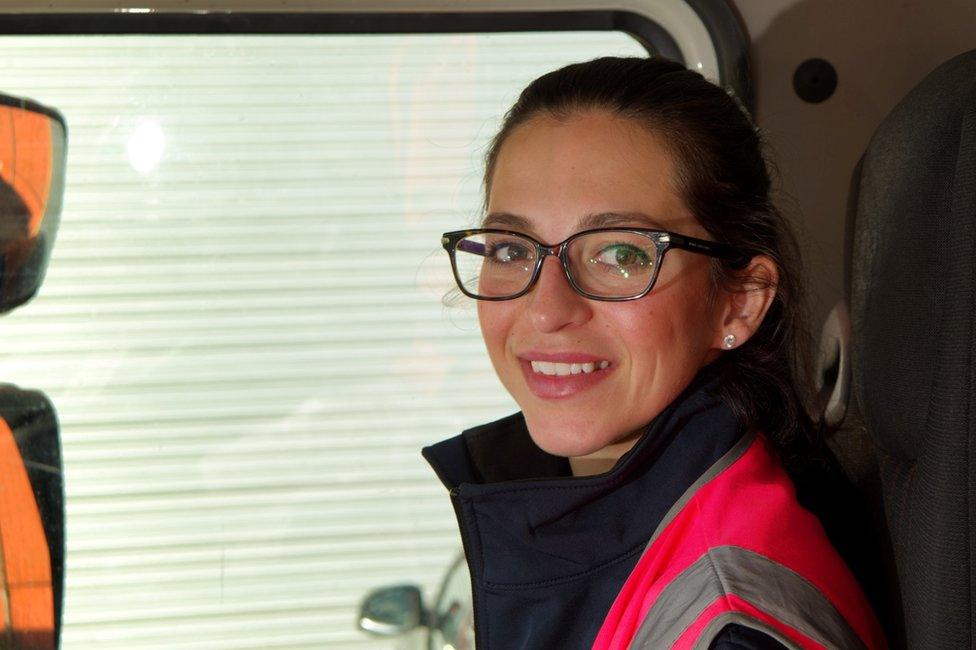
Ms Jobsz says she loves her job and would encourage more women to join to the industry
Mindful that, as a young female driver, she is in a tiny minority out on the road, Ms Jobsz has decided to add some personal touches to her cab.
A squidgy pink air freshener hangs from the ceiling and an equally bright pink metal plate bearing her name sit proudly against her front windscreen.
"I bought it off eBay for £3," says Ms Jobsz, who also wears a bright pink high-visibility vest and shares her driving experiences under the name pinkladytrucker on Instagram, external.
"I've had a few drivers with me when I have been chaperoning them for the day and, quite often, when we've got to a drop, the first comment someone will ask is 'she's in training then?'.
"And they automatically assume that even though I'm driving the lorry that the guy that's with me is training me, when in fact it's the other way around.
"I'm qualified and they are on their way to being qualified but not there yet.
"That's one of the reasons I put the Yasmin plate up there [against the windscreen] - so people know I'm the driver."
Has she always dreamed of being a lorry driver?
Erm, no.
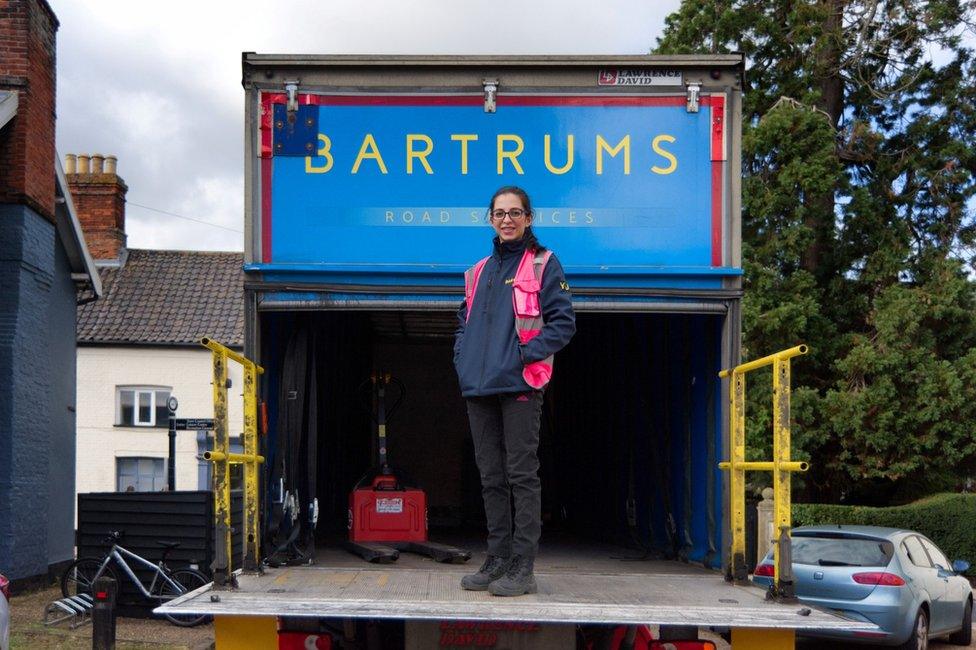
Ms Jobsz got her HGV Class 2 licence in order to drive her horses around
As a young girl, she always wanted to be a professional show jumper.
But her life with horses and driving a lorry are intimately connected.
"I did a lot of show jumping and competing and obviously the horses need to be transported so I took my [HGV Class2] test to be able to drive my horses around," she says.
"I really enjoyed it but I didn't really ever think of being a lorry driver at the time.
"Fast forward two or three years and here I am.
"I knew there was a shortage because I was hearing about it everywhere and it just completely bypassed my mind that I was already qualified to do it.
"And then I saw a poster up saying a local firm needed drivers and suddenly the thought came to me that I could do that.
"Horses were my life. I actually spent five years of my life building up a small equestrian stables - which I have still got - and then in the space of about two days I put that all on the backburner to become a lorry driver.
"I really enjoy it," she says. "It is nice being high up and I guess when I was riding horses I had a view from high up and I was on a powerful animal and I've got a view from high up now and I am driving a powerful truck."
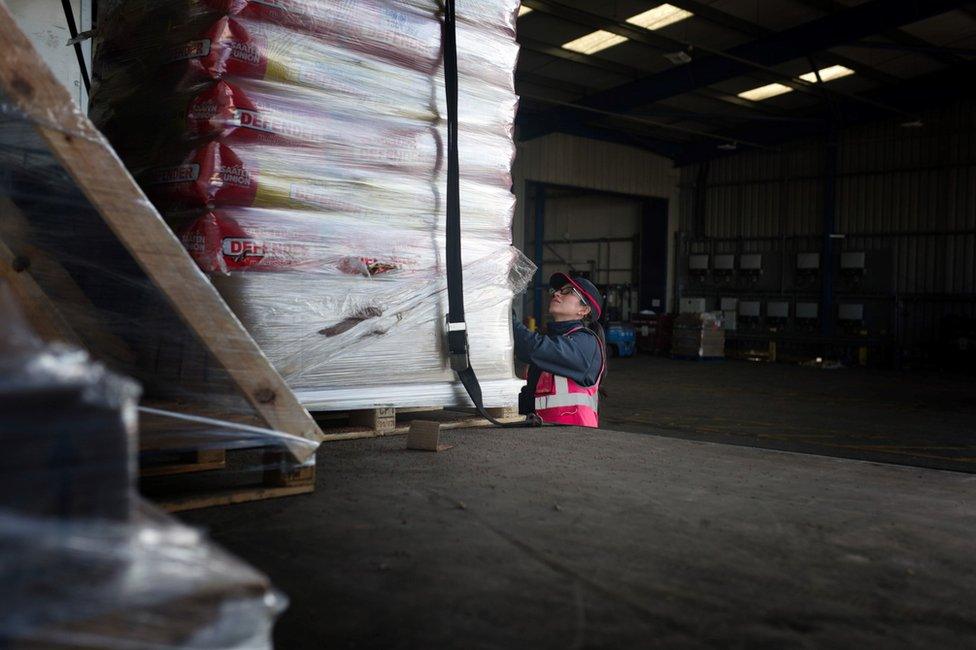
Ms Jobsz's day starts with checking the load against the delivery sheets to make sure she has all the items she needs to deliver
Driving, however, is only part of the job.
Her day starts with checking the load against the delivery sheets to make sure she has all the items she needs to deliver.
Then she has to make sure everything is properly secured and strapped in before drawing the heavy side curtains closed and fixing them in.
"The goods that I carry are all palletised and there can sometimes be one, two, three or seven pallets all going to the same place," she says.
"I will scan all the pallets to make sure I've got all the deliveries I am meant to have, then I will secure the load, do my vehicle checks to make sure everything on the lorry is as it should be and then will set about my day.
"Either the pallets will be forklifted off at the destination or I will put the tail lift down and take them off myself using the pump truck on the back."
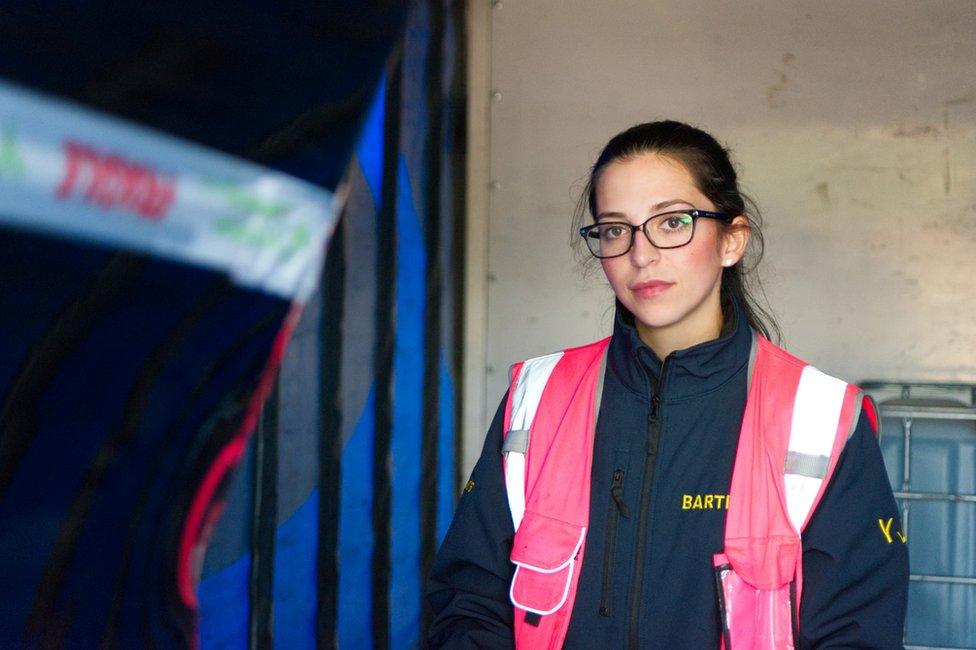
For some deliveries, Ms Jobsz will use a pump truck [a small manually operated forklift] to bring items off her truck
Those who have never driven a lorry might also be surprised by the amount of planning that goes into driving.
Ms Jobsz, for example, plans routes she is unfamiliar with, checking where the lorry entry points are for various sites, the possible pinch points she needs to be mindful of in residential or winding rural roads.
Other things to consider are whether she would be better reversing into some places to ensure she will be able to exit safely after a delivery is made.
She also needs to consider which side of the lorry a particular load is on, she says, because that will also determine which way she needs to be facing when arriving at some locations.
"The average motorist is probably wondering what on earth I am doing," she says, while reversing into one site.
"The ideal situation is that they sit and wait for us to do our manoeuvre because we do what we do for a reason but quite often cars will nip in and out and think we're just in the way.
"Car drivers get quite impatient when you're blocking up a road."
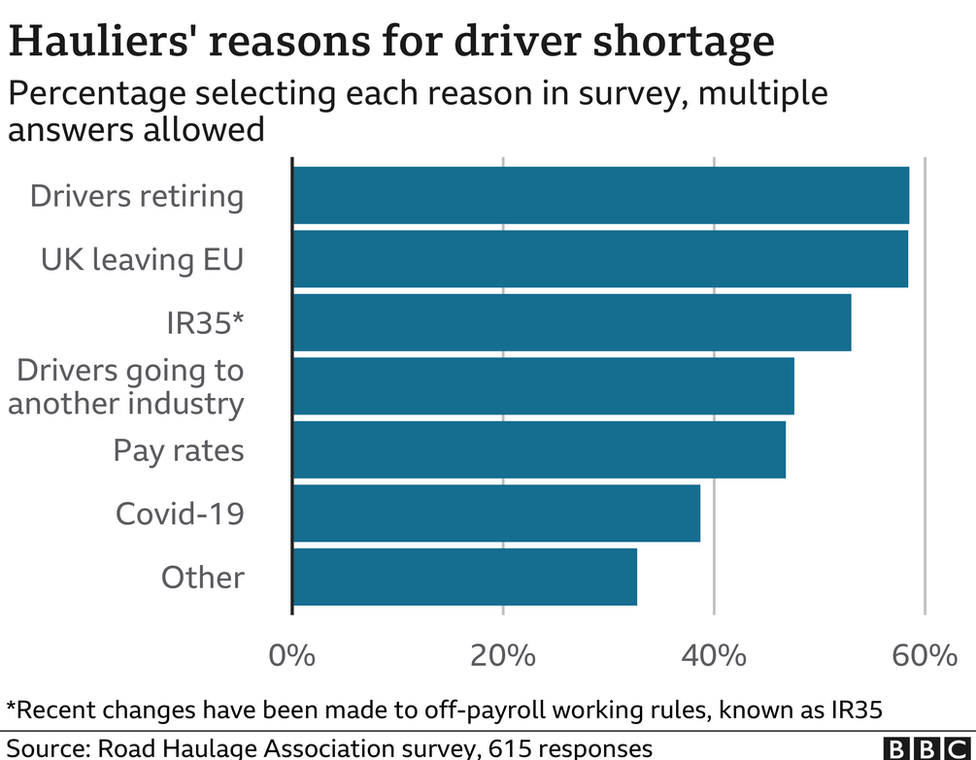
"The more you do it, the easier it becomes to reverse a lorry in tight, awkward spaces, and you get used to car drivers looking at you and wondering what you're doing," says Ms Jobsz.
But getting "stressed" or "frustrated" is not an option when you're driving a lorry, she says, "because that's when things can go wrong".
She has to be very mindful of the "feel" of her lorry, she says, because it changes each time a delivery is made.
Not only does the lorry get lighter but the placement of the loads remaining can make one side slightly heavier than before.
"When I am going through residential areas or down single track country lanes I do have to be very aware of the size and weight of the vehicle."
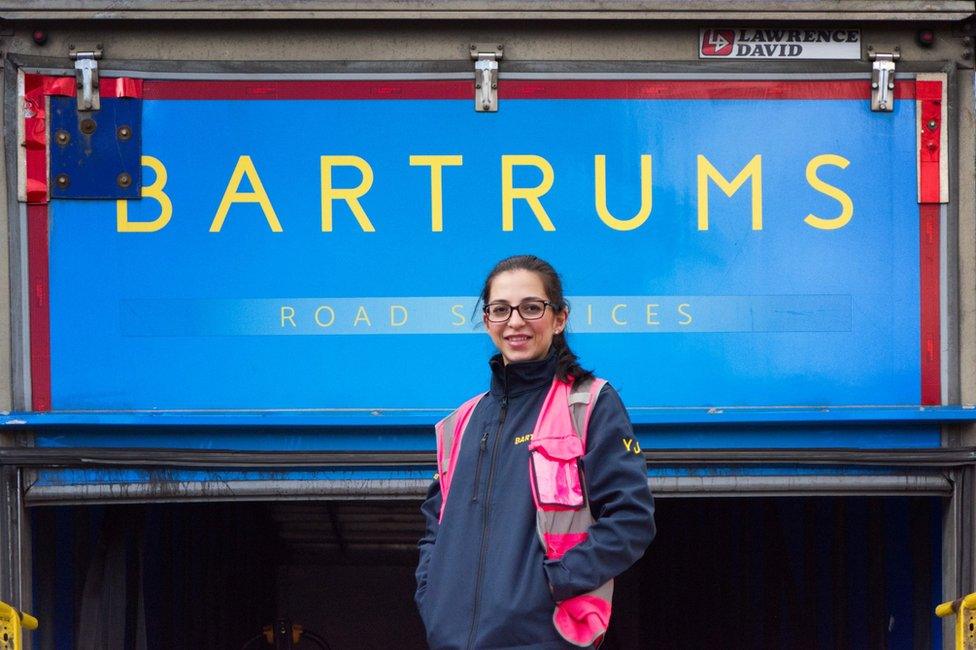
Ms Jobsz hopes one day to drive the larger articulated lorries on longer, multi-day routes
As for future, Ms Jobsz has her eyes set on getting an HGV Class1 licence, which would allow her to drive the larger articulated lorries. At Bartrums, HGV 1 drivers can expect to earn between £40,000 and £60,000 a year, the company said.
"I'm a mum with a young toddler," she says. "But one day I would like to do long distance driving, such as the tramping where you go out Monday to Friday on long distance journeys and abroad as well.
"Before I had my little girl, I was always going on lonesome adventures.
"I would be mindful of the fact that I am a young, small female but, other than that, I would want to do it. I know that shouldn't be a thought or a consideration but it is.
"I'm definitely going to do the test and hopefully pass it and probably have a dabble at class one work."
You might also be interested in:
The one thing she does not particularly enjoy - a concern shared by lorry drivers across the country - is the lack of comfort facilities available.
"We are on the road all day long," she says. "I only do the local deliveries but, even doing those, there are no service stations really for me to pull in to for a comfort break.
"It is difficult planning breaks for starters, but it is even harder planning breaks where there are safe facilities for a comfort break.
"I think it is crazy that lorries are on the road all day long yet there are not set places for us to go to.
"It is not good."
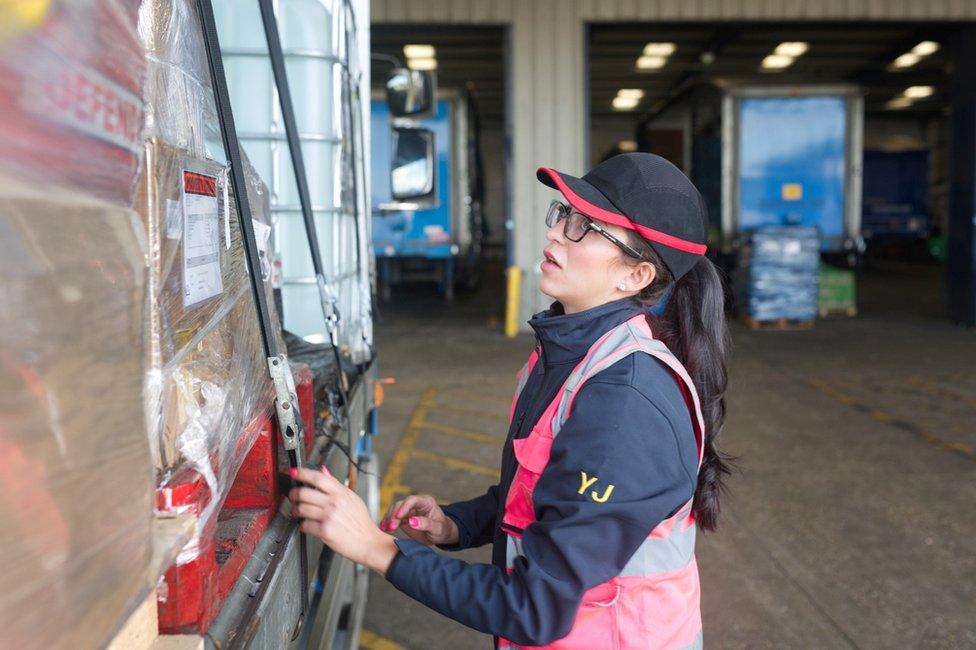
Driving a car after a day in a lorry is like "driving a go-kart" says Ms Jobsz
And after a long day driving an 18-tonne truck she then gets into a car to collect her daughter from childcare.
What is it like to drive a car after a lorry?
"It is like driving a go-kart," she says.
"They feel so low down and you feel like you can nip around everywhere because you've spent the whole day driving really carefully in a big, long vehicle."
Photography by Laurence Cawley

Find BBC News: East of England on Facebook, external, Instagram, external and Twitter, external. If you have a story suggestion email eastofenglandnews@bbc.co.uk, external
- Published15 October 2021
